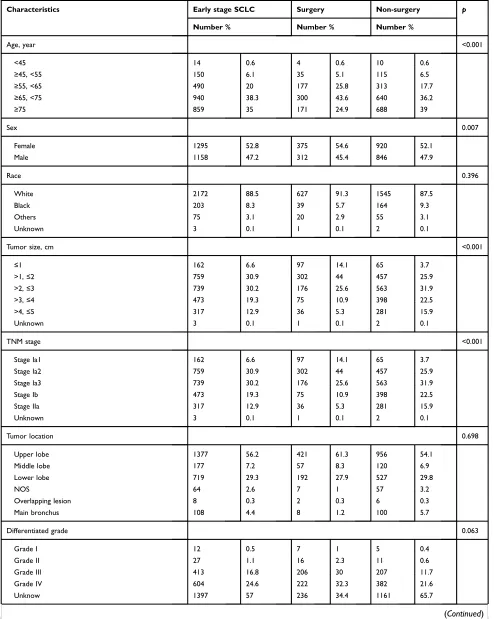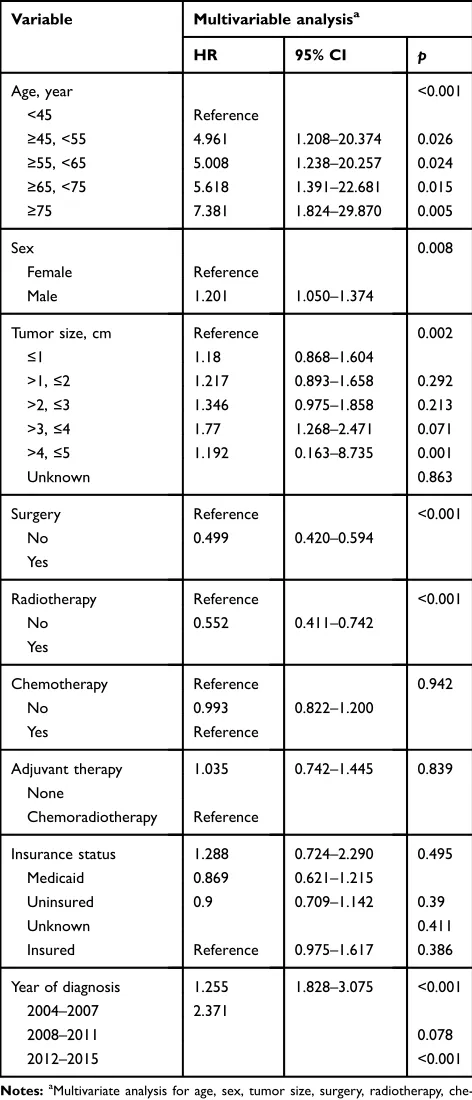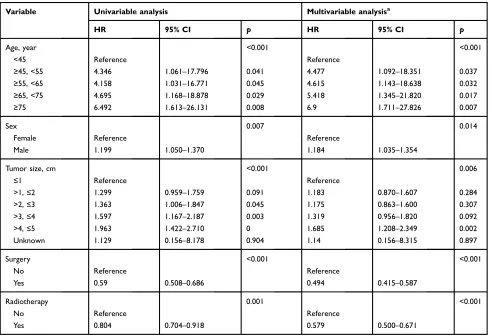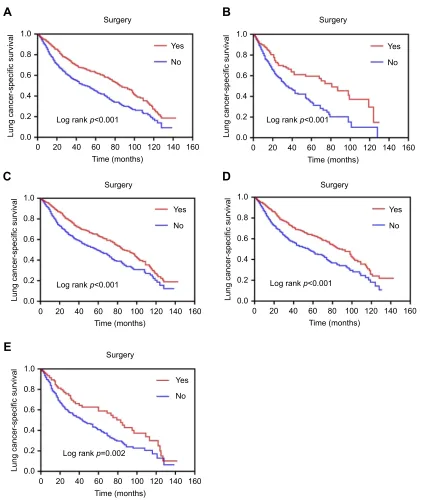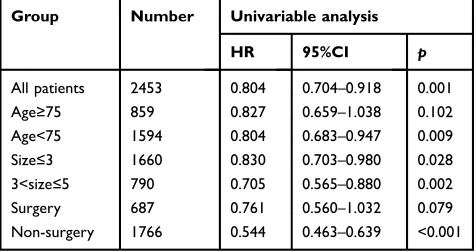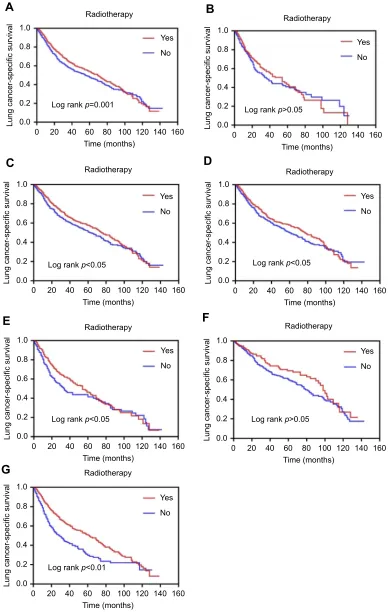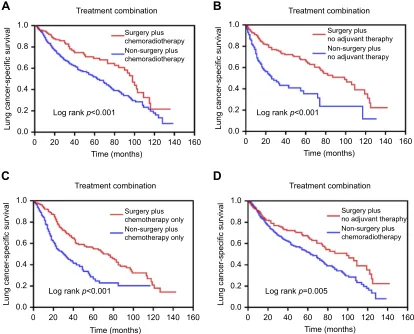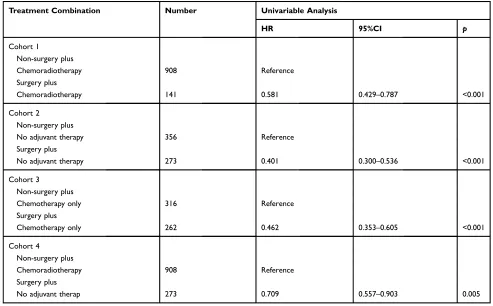O R I G I N A L R E S E A R C H
Role of surgery in patients with early stage
small-cell lung cancer
This article was published in the following Dove Press journal: Cancer Management and Research
Aimei Peng1,* Guoshu Li1,* Mengting Xiong2,* Shuanshuan Xie1 Changhui Wang1
1Department of Respiratory Medicine, Shanghai Tenth People’s Hospital, Tongji University, Shanghai 200072, People’s Republic of China;2Department of Respiratory Medicine, Pulmonary Hospital, Tongji University, Shanghai 200433, People’s Republic of China
*These authors contributed equally to this work
Purpose: Currently, systemic chemotherapy combined with thoracic radiation is the stan-dard treatment for patients with small-cell lung cancer (SCLC). However, the treatment of early stage SCLC remains controversial. This study evaluated the survival outcomes of surgical treatments and the effect of adjuvant chemotherapy and radiotherapy on lung cancer-specific survival (LCSS) in patients with early stage SCLC.
Methods: Using the Surveillance, Epidemiology, and End Results registry, we identified 2,453 patients with early stage SCLC (1,295 women and 1,158 men) who had complete clinical information between 2004 and 2015. The Kaplan-Meier analysis was used to determine the propensity score based on the characteristics of patients with early stage SCLC. LCSS was compared between patients treated with surgery and non-surgery after adjusting, stratifying, or matching patients with early stage SCLC. In addition, we compared the effects of chemotherapy and radiotherapy on LCSS in patients with early stage SCLC.
Results:Overall, 687 (28.0%) and 1,766 (72.0%) patients with early stage SCLC did and did not undergo surgery, respectively. Kaplan-Meier analysis demonstrated a statistically significant difference in survival curves between the surgery and non-surgery groups (log-rank p<0.001). Compared with the non-surgery group, the LCSS of the surgery group was better (hazard ratio [HR]:0.494, 95% confidence interval [CI]:0.415–0.587,
p<0.001) in patients with early stage SCLC when using a Cox model for multivariate analysis. There was no statistically significant difference (p=0.847) in LCSS between patients with early stage SCLC with and without chemotherapy in the multivariate analysis. Radiotherapy had favorable effects on LCSS (HR: 0.579, 95% CI: 0.500–0.671, p<0.001) in patients with early stage SCLC using multivariate analysis.
Conclusions: Our study results suggest that LCSS conferred by surgery was higher than that conferred by non-surgery and that radiotherapy is associated with better survival in patients with early stage SCLC. This study findings should be confirmed in prospective studies.
Keywords:early stage small-cell lung cancer, surgery, lung cancer-specific survival, SEER, chemotherapy, radiotherapy
Introduction
Lung cancer is a serious threat to human health and its incidence has risen rapidly in recent years. According to statistical data, lung cancer was the second most common cancer (approximately 13%) and the leading cause of tumor-related death
(approximately 26%) in the United States in 2016.1Small-cell lung cancer (SCLC)
is a pathological type, accounting for about 15% of all lung cancer.2 Due to its
aggressive nature and early metastasis, approximately two-thirds of SCLC patients
are diagnosed with advanced disease and have a poor prognosis.3However, some
Correspondence: Shuanshuan Xie; Changhui Wang
Department of Respiratory Medicine, Shanghai Tenth People’s Hospital, Tongji University, No. 301, Yanchang Middle Road, Jing’an District, Shanghai 200072, People’s Republic of China
Tel +86 21 6630 1685 Fax +86 21 6630 1685
Email xieshuanshuan@aliyun.com; wang-chang-hui@hotmail.com
Cancer Management and Research
Dove
press
open access to scientific and medical research
Open Access Full Text Article
Cancer Management and Research downloaded from https://www.dovepress.com/ by 118.70.13.36 on 20-Aug-2020
patients are diagnosed at a stage in which their disease
may be curable.4 Patients with early stage SCLC who
underwent surgery had a reported five-year survival rate
of 40% to 60%.5–9
Historically, SCLC was treated by surgery. However,
the Medical Research Council performed a trial10 in the
1960s that demonstrated the poor survival of patients who underwent surgery. This outcome resulted in the abandon-ment of surgery and the use of chemotherapy as a standard method for SCLC treatment. Subsequently, two meta-analyses11,12reported that systemic chemotherapy in
com-bination with thoracic radiation improved survival,
a treatment that has become the standard for patients with SCLC.
However, the treatment of SCLC remains controver-sial. Some institutions have reported good results in
patients with early stage SCLC who received surgery.5,13
Other studies have reported favorable results in patients
with stage III SCLC who be interfered with surgery.7,14
Therefore, this study aimed to investigate the effects of
surgical resection on lung cancer-specific survival (LCSS)
in patients with early stage SCLC. We also analyzed the effect of adjuvant chemotherapy and radiotherapy on the LCSS in these patients.
Methods
Data source
The data used in this study were from the Surveillance, Epidemiology, and End Results (SEER) database. The SEER database is sponsored by the National Cancer Institute of the US and provides registry information on cancer including pathological type, patient survival, sur-gery, and adjuvant therapy since 1973.
Study population
We limited the cohort to patients with early stage SCLC diagnosed from 2004 to 2015. All early stage SCLC patients were staged using American Joint Committee on Cancer with stage I or IIa (stage T1-2N0M0) disease. Patients who underwent surgery were staged pathologically and those without surgery had clinic staging. Complete patient infor-mation was available in the SEER database.
Covariates
The baseline characteristics based on 17 covariates included age, sex, race, tumor size, TNM stage, tumor location, differ-entiated grade, laterality, surgery, radiotherapy, chemotherapy,
insurance status, year of diagnosis, marital status, geographic region, high school education, and median household income. To better analyze the effects of adjuvant therapy on LCSS, we created a new covariate called adjuvant therapy, defined as patients who received one or both treatments (chemotherapy, radiotherapy or chemoradiotherapy).
Statistical analyses
All data were analyzed using IBM SPSS, version 20.0 (IBM Corp, Armonk, NY, USA). Kaplan-Meier analysis was used to compare survival between the surgery and non-surgery groups. Propensity score methods were used to control for potential differences in baseline characteristics of the included patients. Cox regression was performed to assess the balance of the baseline covariates of the two groups after adjusting for the estimated propensity scores.
Results
Study cohort characteristics
We identified 2,453 patients with early stage SCLC, of
whom 687 (28.0%) underwent surgery as a primary treat-ment and 1,766 (72.0%) did not between 2004 and 2015.
Table 1 shows the baseline characteristics of all patients
identified through the SEER database. The results of
Kaplan-Meier analyses demonstrated statistically signifi
-cant differences in LCSS between the two groups with
regard to age (p<0.001), sex (p=0.007), tumor size
(p<0.001), TNM stage (p<0.001), radiotherapy (p=0.001), chemotherapy (p=0.026), insurance status (p<0.001), adju-vant therapy (p=0.007), and year of diagnosis (p<0.001).
However, no significant differences in LCSS were
observed with respect to race (p=0.396), tumor location
(p=0.698), differentiated grade (p=0.063), laterality
(p=0.611), marital status (p=0.426), geographic region
(p=0.069), high school education (p=0.138), and median
household income (p=0.470) (Table 1).
A Cox model for multivariate analysis including the
above significant covariates (TNM stage was excluded due
to covariates tumor size and TNM stage linearly related)
showed statistically significant differences for age
(p<0.001), sex (p=0.008), tumor size (p=0.002), surgery (p<0.001), radiotherapy (p<0.001), and year of diagnosis (p<0.001). Covariates such as chemotherapy (p=0.942), insurance status (p=0.495), and adjuvant therapy (p=0.839) did not differ significantly (Table 2). Subsequent analysis
using a new Cox model includingfive covariates (age, sex,
tumor size, surgery, and radiotherapy) revealed statistically
Cancer Management and Research downloaded from https://www.dovepress.com/ by 118.70.13.36 on 20-Aug-2020
Table 1 Baseline characteristics of patients treated with surgery or non-surgery in the Surveillance, Epidemiology and End Results (SEER) Program, 2004–2015
Characteristics Early stage SCLC Surgery Non-surgery p
Number % Number % Number %
Age, year <0.001
<45 14 0.6 4 0.6 10 0.6
≥45, <55 150 6.1 35 5.1 115 6.5
≥55, <65 490 20 177 25.8 313 17.7
≥65, <75 940 38.3 300 43.6 640 36.2
≥75 859 35 171 24.9 688 39
Sex 0.007
Female 1295 52.8 375 54.6 920 52.1
Male 1158 47.2 312 45.4 846 47.9
Race 0.396
White 2172 88.5 627 91.3 1545 87.5
Black 203 8.3 39 5.7 164 9.3
Others 75 3.1 20 2.9 55 3.1
Unknown 3 0.1 1 0.1 2 0.1
Tumor size, cm <0.001
≤1 162 6.6 97 14.1 65 3.7
>1,≤2 759 30.9 302 44 457 25.9
>2,≤3 739 30.2 176 25.6 563 31.9
>3,≤4 473 19.3 75 10.9 398 22.5
>4,≤5 317 12.9 36 5.3 281 15.9
Unknown 3 0.1 1 0.1 2 0.1
TNM stage <0.001
Stage Ia1 162 6.6 97 14.1 65 3.7
Stage Ia2 759 30.9 302 44 457 25.9
Stage Ia3 739 30.2 176 25.6 563 31.9
Stage Ib 473 19.3 75 10.9 398 22.5
Stage IIa 317 12.9 36 5.3 281 15.9
Unknown 3 0.1 1 0.1 2 0.1
Tumor location 0.698
Upper lobe 1377 56.2 421 61.3 956 54.1
Middle lobe 177 7.2 57 8.3 120 6.9
Lower lobe 719 29.3 192 27.9 527 29.8
NOS 64 2.6 7 1 57 3.2
Overlapping lesion 8 0.3 2 0.3 6 0.3
Main bronchus 108 4.4 8 1.2 100 5.7
Differentiated grade 0.063
Grade I 12 0.5 7 1 5 0.4
Grade II 27 1.1 16 2.3 11 0.6
Grade III 413 16.8 206 30 207 11.7
Grade IV 604 24.6 222 32.3 382 21.6
Unknow 1397 57 236 34.4 1161 65.7
(Continued)
Cancer Management and Research downloaded from https://www.dovepress.com/ by 118.70.13.36 on 20-Aug-2020
Table 1(Continued).
Characteristics Early stage SCLC Surgery Non-surgery p
Number % Number % Number %
Laterality 0.611
Right-origin of primary 1389 56.6 406 59.1 983 55.7
Left-origin of primary 1059 43.2 280 40.8 779 44.1
Paired site, but no information concerning laterality 2 0.1 1 0.1 2 0.1
Not a paired site 3 0.1 0 0 2 0.1
Radiotherapy 0.001
No 1207 49.2 535 77.9 672 38.1
Yes 1246 50.8 152 22.1 1094 61.9
Chemotherapy 0.026
No 826 33.7 284 41.3 542 30.7
Yes 1627 66.3 403 58.7 1224 69.3
Adjuvant therapy 0.007
None 629 25.6 273 39.7 356 20.2
Chemoradiotherapy 1049 42.8 141 13.4 908 86.6
Chemotherapy only 578 23.6 262 45.3 316 54.7
Radiotherapy only 197 8 11 5.6 186 94.4
Insurance status <0.001
Medicaid 242 9.9 56 8.2 186 10.5
Uninsured 31 1.3 9 1.3 22 1.3
Unknown 627 25.5 176 25.6 451 25.5
Insured 1553 63.3 446 64.9 1107 62.7 0.426
Marital status
Married 1195 48.7 364 53 831 47.1
Single 272 11.1 72 10.5 200 11.3
Divorced 354 14.4 98 14.3 256 14.5
Widowed 541 22.1 127 18.5 414 23.4
Unknown 90 3.7 25 3.6 65 3.7
Unmarried or Domestic Partner 1 0 1 0.1 0 0 <0.001
Year of diagnosis
2004–2007 807 32.9 230 33.5 577 32.7
2008–2011 787 32.1 226 32.9 561 31.7
2012–2015 859 35 231 33.6 628 35.6 0.069
Geographic region
East 1284 52.3 395 57.5 889 50.3
Northwest 777 31.7 197 28.7 580 32.9
North 321 13.1 77 11.2 244 13.8
Southwest 71 2.9 18 2.6 53 3 0.138
High school education
≥21 449 18.3 129 18.8 320 18.1
13–20 739 30.1 186 27.1 553 31.3
(Continued)
Cancer Management and Research downloaded from https://www.dovepress.com/ by 118.70.13.36 on 20-Aug-2020
significant differences for age (p<0.001), sex (p=0.014), tumor size (p=0.006), surgery (p<0.001), and radiotherapy (p<0.001) (Table 3).
Comparison of disease-speci
fi
c mortality
and median survival time between the
surgery and non-surgery groups
The overall lung cancer-specific mortality rate in patients with early stage SCLC was 35.8% (879/2453). The mor-tality rates were 35.2% (242/687) and 36.1% (637/1766) for the surgery and non-surgery groups, respectively. The overall median survival time for patients with early stage SCLC was 17 months. The median survival times in the surgery and non-surgery groups were 26 and 15 months,
respectively (Table 4). Compared to that in the
non-surgery group, the crude hazard ratio (HR) and 95%
con-fidence interval (CI) was 0.590 (0.508–0.686,p<0.001) for the surgery group in patients with early stage SCLC. After adjusting for age, sex, tumor size, surgery, and radiother-apy, the HR (95% CI) for the surgery group was 0.494 (0.415–0.587, p<0.001) (Table 3). The median survival
time and HR of the surgery group were significantly better
than those in the non-surgery group.
Kaplan-Meier analysis of disease-speci
fi
c
survival between the surgery and
non-surgery groups
Kaplan-Meier analysis revealed statistically significant differ-ences in survival curves and log-rank tests between the two groups. Among all patients with early stage SCLC, the survi-val (log-rank p<0.001) of the surgery group was better than
that of the non-surgery group (Figure 1A). Similarly, the
survival (log-rankp<0.001) of the surgery group was better
than that of the non-surgery group in patients aged≥75 years (Figure 1B). The survival advantage (log-rankp<0.001) in the surgery group persisted in patients aged <75 years (Figure 1C). In addition, the survival (log-rank p<0.001) of the surgery group was better than that of the non-surgery group for patients with tumor size T1 (≤3 cm) (Figure 1D). The survival advantage (log-rankp=0.002) in the surgery group persisted in patients with tumor size T2 (3 cm< and≤5 cm) (Figure 1E).
Our data demonstrated the significant effect of surgery on
disease-specific survival in patients with early stage SCLC.
Comparison of the effects of adjuvant
therapy in patients with early stage SCLC
Kaplan–Meier analysis showed a statistically significant dif-ference (p=0.026) in the LCSS in patients with early stageSCLC who received chemotherapy (Table 1). However, this
difference disappeared in the Cox model (p=0.847) (Table 2). Similarly, there was a significant difference (p=0.031) in LCSS in patients with early stage SCLC who received
adju-vant therapy (Table 1), which also disappeared in the Cox
model (p=0.839) (Table 2).
Kaplan-Meier analysis also revealed a statistically signifi -cant difference (p=0.001) in LCSS in patients with early stage SCLC who received radiotherapy by (Table 1). In a Cox model including nine covariates, the HR (95% CI) was 0.572 (0.479–0.682,p<0.001) for patients who received radiother-apy compared to those without (Table 2). After adjusting for age, sex, tumor size, surgery, and radiotherapy, the HR (95%
CI) was 0.579 (0.500–0.671, p<0.001) in patients who
received radiotherapy (Table 3).
The effects of radiotherapy on LCSS are also shown in
Table 6. The HR (95% CI) of patients with radiotherapy
was 0.804 (0.704–0.918, p=0.001) compared to patients
without radiotherapy. Similarly, compared to patients
Table 1(Continued).
Characteristics Early stage SCLC Surgery Non-surgery p
Number % Number % Number %
7–12 1083 44.2 319 46.4 764 43.3
<7 182 7.4 53 7.7 129 7.3 0.47
Median household income (dollar, in tens)
<38000 221 9 69 10.1 152 8.6
38000–47999 488 19.9 119 17.3 369 20.9
48000–62999 942 38.4 250 36.4 692 39.2
>63000 802 32.7 249 36.2 553 31.3
Abbreviations:SCLC, small-cell lung cancer; NOS, not otherwise specified.
Cancer Management and Research downloaded from https://www.dovepress.com/ by 118.70.13.36 on 20-Aug-2020
without radiotherapy, the HR (95% CI) was 0.804
(0.683–0.947, p=0.009) among patients aged <75 years.
However, compared to patients without radiotherapy aged
≥75 years, there was no significant difference (p=0.102) in
LCSS. Among patients with T1 (tumor size ≤3 cm), the
HR (95% CI) of patients who received radiotherapy was
0.830 (0.703–0.980,p=0.028) compared to those without
radiotherapy. Compared to patients without radiotherapy, the HR (95% CI) of patients with radiotherapy was 0.705
(0.565–0.880, p=0.002) in patients with T2 (3 cm< and
≤5 cm). In addition, the HR (95% CI) of patients with
radiotherapy was 0.544 (0.463–0.639,p<0.001) compared to those without radiotherapy or surgery. However, there
was no statistically significant difference (p=0.079) in
LCSS regardless of radiotherapy among patients who underwent surgery (Table 5).
The effects of radiotherapy on the survival curves are
shown inFigure 2. In patients with early stage SCLC, the
survival curve (log-rank p<0.001) of patients with radio-therapy was better than that in those without radioradio-therapy (Figure 2A). However, there was no statistically significant
difference in survival curve (log-rank p>0.05) between
patients with and without radiotherapy among those aged
≥75 years (Figure 2B). However, the survival curve
(log-rankp<0.05) of patients with radiotherapy was better than that of those without radiotherapy among those aged
<75 years (Figure 2C). Among patients with T1 (tumor
sizes≤3 cm) (log-rankp<0.05) and T2 (3 cm< and≤5 cm), the survival curves of patients with radiotherapy were better than those of patients without radiotherapy (log-rankp<0.05) (Figure 2DandE). In patients with surgery, there was no significant difference in survival curves (log-rankp>0.05) between patients with and without
radiother-apy (Figure 2F). However, among those without surgery,
the survival curve (log-rank p<0.001) of patients with
radiotherapy was better than that of those without radio-therapy (Figure 2G).
Comparison of the effects of treatment
combinations in patients with early stage
SCLC
According to the patient’s adjuvant therapy plans, we divided the patients with early stage SCLC into four cohorts: patients with chemoradiotherapy (cohort 1), patients without any adjuvant therapy (cohort 2), patients with chemotherapy only (cohort 3) and patients with chemoradiotherapy plus without any adjuvant therapy (cohort 4). Subsequently, we set up treatment combinations: non-surgery plus chemora-diotherapy group and surgery plus chemorachemora-diotherapy group in cohort 1, non-surgery plus no adjuvant therapy group and surgery plus no adjuvant therapy group in cohort 2,
non-Table 2 Multivariate analysis using a cox proportional hazards model in patients with early stage SCLC
Variable Multivariable analysisa
HR 95% CI p
Age, year <0.001
<45 Reference
≥45, <55 4.961 1.208–20.374 0.026 ≥55, <65 5.008 1.238–20.257 0.024 ≥65, <75 5.618 1.391–22.681 0.015
≥75 7.381 1.824–29.870 0.005
Sex 0.008
Female Reference
Male 1.201 1.050–1.374
Tumor size, cm Reference 0.002
≤1 1.18 0.868–1.604
>1,≤2 1.217 0.893–1.658 0.292
>2,≤3 1.346 0.975–1.858 0.213
>3,≤4 1.77 1.268–2.471 0.071
>4,≤5 1.192 0.163–8.735 0.001
Unknown 0.863
Surgery Reference <0.001
No 0.499 0.420–0.594
Yes
Radiotherapy Reference <0.001
No 0.552 0.411–0.742
Yes
Chemotherapy Reference 0.942
No 0.993 0.822–1.200
Yes Reference
Adjuvant therapy 1.035 0.742–1.445 0.839 None
Chemoradiotherapy Reference
Insurance status 1.288 0.724–2.290 0.495
Medicaid 0.869 0.621–1.215
Uninsured 0.9 0.709–1.142 0.39
Unknown 0.411
Insured Reference 0.975–1.617 0.386
Year of diagnosis 1.255 1.828–3.075 <0.001 2004–2007 2.371
2008–2011 0.078
2012–2015 <0.001
Notes:a
Multivariate analysis for age, sex, tumor size, surgery, radiotherapy, che-motherapy, insurance status, adjuvant therapy and year of diagnosis.
Abbreviations:SCLC, small-cell lung cancer; HR, hazard ratio; CI, confidence interval.
Cancer Management and Research downloaded from https://www.dovepress.com/ by 118.70.13.36 on 20-Aug-2020
surgery plus chemotherapy only group and surgery plus chemotherapy only group in cohort 3 as well as non-surgery plus chemoradiotherapy group and non-surgery plus no adjuvant therapy group in cohort 4. In all cohorts, there were significant differences in survival curves and log-rank tests
between the two groups in the same cohort (Figure 3). The
survival curve (log-rank p<0.001) of the surgery plus che-moradiotherapy group was better than that of the non-surgery
plus chemoradiotherapy group in cohort 1 (Figure 3A).
Similarly, the survival curve (log-rankp<0.001) of the sur-gery plus no adjuvant therapy group was better than that of
the non-surgery plus no adjuvant therapy group in cohort 2 (Figure 3B), and the survival curve (log-rankp<0.001) of the surgery plus chemotherapy only group was better than that of the non-surgery plus chemotherapy only group in cohort 3 (Figure 3C). In addition, the survival curve (log-rank
p=0.005) of the surgery plus no adjuvant therapy group was
also better than that of the non-surgery plus chemoradiother-apy group in cohort 4 (Figure 3D).
Analogous results were showed inTable 7by
univari-able analysis. Compared to the non-surgery plus chemor-adiotherapy group, the HR (95% CI) of the surgery plus
chemoradiotherapy group was 0.581 (0.429–0.787,
p<0.001) in cohort 1. The HR (95% CI) of the surgery
plus no adjuvant therapy group was 0.401 (0.300–0.536,
p<0.001) compared to the non-surgery plus no adjuvant
therapy group in cohort 2. The HR (95% CI) of the surgery
plus chemotherapy only group was 0.462 (0.353–0.605,
p<0.001) compared to the non-surgery plus chemotherapy
only group in cohort 3. The HR (95% CI) of the surgery
plus no adjuvant therapy group was 0.709 (0.557–0.903,
Table 3Univariable and multivariable analyses on LCSS in patients with early stage SCLC
Variable Univariable analysis Multivariable analysisa
HR 95% CI p HR 95% CI p
Age, year <0.001 <0.001
<45 Reference Reference
≥45, <55 4.346 1.061–17.796 0.041 4.477 1.092–18.351 0.037
≥55, <65 4.158 1.031–16.771 0.045 4.615 1.143–18.638 0.032
≥65, <75 4.695 1.168–18.878 0.029 5.418 1.345–21.820 0.017
≥75 6.492 1.613–26.131 0.008 6.9 1.711–27.826 0.007
Sex 0.007 0.014
Female Reference Reference
Male 1.199 1.050–1.370 1.184 1.035–1.354
Tumor size, cm <0.001 0.006
≤1 Reference Reference
>1,≤2 1.299 0.959–1.759 0.091 1.183 0.870–1.607 0.284
>2,≤3 1.363 1.006–1.847 0.045 1.175 0.863–1.600 0.307
>3,≤4 1.597 1.167–2.187 0.003 1.319 0.956–1.820 0.092
>4,≤5 1.963 1.422–2.710 0 1.685 1.208–2.349 0.002
Unknown 1.129 0.156–8.178 0.904 1.14 0.156–8.315 0.897
Surgery <0.001 <0.001
No Reference Reference
Yes 0.59 0.508–0.686 0.494 0.415–0.587
Radiotherapy 0.001 <0.001
No Reference Reference
Yes 0.804 0.704–0.918 0.579 0.500–0.671
Notes:a
Multivariate analysis for age, sex, tumor size, radiotherapy, surgery and chemotherapy.
Abbreviations:LCSS, lung cancer-specific survival; SCLC, small-cell lung cancer; HR, hazard ratio; CI, confidence interval.
Table 4 Association with cancer-specific mortality and median survival time among patient groups (SEER database, 2004–2015)
Group Mortality, % (n/N) Median survival time (months)
Overall 35.8% (879/2453) 17 Non-surgery 35.2% (242/687) 15 Surgery 36.1% (637/1766) 26
Abbreviations:SEER, Surveillance, Epidemiology and End Results.
Cancer Management and Research downloaded from https://www.dovepress.com/ by 118.70.13.36 on 20-Aug-2020
p=0.005) compared to the non-surgery plus chemora-diotherapy group in cohort 4.
Discussion
Currently, chemoradiotherapy is the standard treatment for early stage SCLC, providing a median overall survival of
16–20 months.15,16 However, the optimal treatment of
early stage SCLC remains controversial. An increasing number of studies suggest that surgical treatment can improve survival outcomes in patients with SCLC, espe-cially in early stage disease.2,7,13,14,17–21 Retrospective studies have reported favorable outcomes for surgery in
A
C
E
D
B
Lung cancer-specific survival
Lung cancer-specific survival Lung cancer-specific survival
Lung cancer-specific survival
Lung cancer-specific survival
Log rank p<0.001
Log rank p<0.001
Log rank p<0.001
Log rank p<0.001
Log rank p=0.002
Yes
Yes
Yes No
No
No 0.8
0.6
0.4
0.2 1.0
0.0
20 60 80
Surgery
Surgery
Surgery
Surgery Surgery
Time (months) Time (months)
Time (months)
Time (months)
Time (months) 100 120 140
0 40 160
0.8
0.6
0.4
0.2 1.0
0.0
20 60 80 100 120 140
0 40 160
Yes
Yes No
No 0.8
0.6
0.4
0.2 1.0
0.0
20 60 80 100 120 140
0 40 160
0.8
0.6
0.4
0.2 1.0
0.0
20 60 80 100 120 140
0 40 160
0.8
0.6
0.4
0.2 1.0
0.0
20 60 80 100 120 140
0 40 160
Figure 1Survival curves based on Kaplan–Meier analysis comparing treatment with surgery versus non-surgery. (A) LCSS (p<0.001) in patients with early stage SCLC; (B) LCSS (p<0.001) in patients with age≥75 years; (C) LCSS (p<0.001) in patients with age <75 years; (D) LCSS (p<0.001) in patients with tumor size T1 (sizes≤3 cm); (E) LCSS (p=0.002) in patients with tumor size T2 (3 cm< sizes≤5 cm).
Abbreviations:LCSS, lung cancer-specific survival; SCLC, small-cell lung cancer.
Cancer Management and Research downloaded from https://www.dovepress.com/ by 118.70.13.36 on 20-Aug-2020
patients with stage I SCLC.22,23 A growing number of patients with early stage SCLC receive surgical treatment, resulting in a favorable overall median survival of 29–91 months.24–27The present study evaluated the survi-val outcomes of surgery versus non-surgery in patients
with early stage SCLC, finding that surgery resulted in
a better LCSS than that of non-surgery. To further analyze the effect of surgery on LCSS in elderly patients with early
stage SCLC, we divided the age covariates into ≥75 and
<75 years. The LCSS of patients receiving surgical treat-ment was better than that of non-surgery in patients aged
≥75 years. Better survival was also observed in surgical
patients aged <75 years than that in those without surgery. We also analyzed the effect of surgery on LCSS in patients with early stage SCLC with varying tumor sizes. We
divided the patients into T1 (≤3 cm) and T2 (3 cm< and
≤5 cm) based on tumor size. Our results showed a superior
LCSS in patients with surgery compared to non-surgery for both T1 and T2. Our results show that surgical treat-ment is superior to non-surgical in patients with early stage
SCLC. This result is consistent with those of the above studies.
At present, chemotherapy is the main treatment for early stage SCLC. We analyzed the effect of chemother-apy on LCSS in patients with early stage SCLC. Univariate analysis revealed statistically significant dif-ferences in LCSS between chemotherapy and
non-chemotherapy patients with early stage SCLC.
However, a Cox model for multivariate analysis
indi-cated no statistically significant difference in LCSS
between these groups. In addition, we defined one or
two rounds of chemotherapy and radiotherapy as
adju-vant therapy. We found a significant difference in
uni-variate analysis, which disappeared in multiuni-variate analysis. According to these outcomes, chemotherapy did not provide significant survival benefits for patients with early stage SCLC. This result may provide a reference for clinicians to select appropriate treatment methods for these patients.
Because SCLC is radiosensitive, radiotherapy can
provide local control for patients with SCLC.4We
ana-lyzed the effect of radiotherapy on LCSS in patients with early stage SCLC. In univariate analysis, the LCSS of patients with radiotherapy was better than that in non-radiotherapy patients. A Cox model for multivariate analysis (included covariates: age, sex, tumor size, surgery, and radiotherapy) also revealed a better LCSS in patients with radiotherapy than that in non-radiotherapy patients. These results suggest that
radiotherapy has a significant effect on LCSS in patients
with early stage SCLC. The patients were further
divided into groups according to age (≥75 or
<75 years), tumor size (T1 or T2), and surgery (yes or no) to analyze the effects of radiotherapy on LCSS in
univariate analysis. Compared to that in
non-radiotherapy patients, the LCSS of patients with
radio-therapy was significantly better among those aged
<75 years. Similarly, the LCSS of patients with
radio-therapy was significantly better than that in those
with-out radiotherapy and withwith-out surgery. However, among
patients aged ≥75 years or with surgery, there was no
advantage for radiotherapy compared to
non-radiotherapy. In addition, radiotherapy can provide
a benefit in LCSS for radiotherapy patients, whether
T1 or T2.
Patients with early stage SCLC might receive multiple treatments including surgery, radiotherapy and chemotherapy.
Table 5 Comparison of the effects of surgery (yes vs no) on LCSS in patients groups by univariate analysis
Group Number Univariable analysis
HR 95%CI p
All patients 2453 0.590 0.508–0.686 <0.001 Age≥75 859 0.529 0.393–0.712 <0.001 Age<75 1594 0.639 0.536–0.763 <0.001 Size≤3 1660 0.612 0.512–0.730 <0.001 3<size≤5 790 0.610 0.445–0.836 0.002
Abbreviations:LCSS, lung cancer-specific survival; HR, hazard ratio; CI, confi -dence interval.
Table 6Comparison of the effects of radiotherapy (yes vs no) on LCSS in patients groups by univariate analysis
Group Number Univariable analysis
HR 95%CI p
All patients 2453 0.804 0.704–0.918 0.001 Age≥75 859 0.827 0.659–1.038 0.102 Age<75 1594 0.804 0.683–0.947 0.009 Size≤3 1660 0.830 0.703–0.980 0.028 3<size≤5 790 0.705 0.565–0.880 0.002
Surgery 687 0.761 0.560–1.032 0.079
Non-surgery 1766 0.544 0.463–0.639 <0.001
Abbreviations:LCSS, lung cancer-specific survival; HR, hazard ratio; CI, confi -dence interval.
Cancer Management and Research downloaded from https://www.dovepress.com/ by 118.70.13.36 on 20-Aug-2020
0.8
0.6
0.4
0.2 1.0
0.0
20 60 80 100 120 140
0 40 160
0.8
0.6
0.4
0.2 1.0
0.0
20 60 80 100 120 140
0 40 160
0.0 1.0
0.8
0.6
0.4
0.2
20 60 80 100 120 140
0 40 160
0.8
0.6
0.4
0.2 1.0
0.0
20 60 80 100 120 140
0 40 160
0.0 1.0
0.8
0.6
0.4
0.2
20 60 80 100 120 140
0 40 160
0.0 1.0
0.8
0.6
0.4
0.2
20 60 80 100 120 140
0 40 160
0.0 1.0
0.8
0.6
0.4
0.2
20 60 80 100 120 140
0 40 160
Yes
No
Yes
No
Yes
No
Yes
No
Yes
No
Yes
No
Yes
No Log rank p=0.001
Log rank p>0.05
Log rank p<0.05
Log rank p<0.05
Log rank p<0.01
Log rank p>0.05 Log rank p<0.05 Time (months)
Radiotherapy
Radiotherapy
Radiotherapy Radiotherapy
Radiotherapy
Radiotherapy Radiotherapy
Time (months)
Time (months)
Time (months)
Time (months) Time (months) Time (months) Lung cancer-specific survival Lung cancer-specific survival
Lung cancer-specific survival
Lung cancer-specific survival
Lung cancer-specific survival
Lung cancer-specific survival
Lung cancer-specific survival
A
C
D
E
G
F
B
Figure 2Comparison of the effects of radiotherapy on LCSS based on Kaplan–Meier analysis. (A) LCSS (p=0.001) in patients with early stage SCLC; (B) LCSS (p>0.05) in patients with age≥75 years; (C) LCSS (p<0.05) in patients with age <75 years; (D) LCSS (p<0.05) in patients with T1 (tumor sizes≤3 cm); (E) LCSS (p<0.05) in patients with T2 (3 cm< sizes≤5 cm); (F) LCSS (p>0.05) in patients with surgery; (G) cancer-specific survival (p<0.001) in patients with non-surgery.
Abbreviations:LCSS, lung cancer-specific survival; SCLC, small-cell lung cancer.
Cancer Management and Research downloaded from https://www.dovepress.com/ by 118.70.13.36 on 20-Aug-2020
Therefore, it was necessary to further discuss the significance of surgery in different treatment combinations. Due to the small number of patients undergoing surgery plus radiother-apy, we did not discuss it further. Our results showed that the combination comprising surgery was superior to the combina-tion without surgery on LCSS in the same cohort. Moreover, surgical treatment was superior to chemoradiotherapy in patients with early stage SCLC (Figure 3D,Table 7). This study further indicates that surgical treatment is a better option for patients with early stage SCLC.
Due to its retrospective design, our study has some limitations. One is the lack of information showing the status of performance or other indicators of the
patient’s physical condition. Another limitation is the
lack of specific treatment information for the patient,
such as chemotherapy regimen, radiation dose and method, and the surgical procedure. However, with
the inclusion of 18 covariates and nearly 2,500 patients in our cohort, the present study represents a well-balanced analysis between surgery and non-surgical methods. Thus, in the absence of data from prospective
trials, our findings provide useful information for the
management of patients with early stage SCLC. In summary, the prognosis of patients with early stage SCLC was related to a variety of factors. According to the results of our study, surgery was superior to non-surgery in patients with early stage SCLC; therefore, we recommend surgical resection as the more favorable choice. In addition,
because radiotherapy may be beneficial for patients with
early stage SCLC, it should be recommended, especially in patients not undergoing surgery and aged <75 years. Understanding this information is critical to the prognosis
of patients with early stage SCLC and ourfindings help in
determining the best treatment strategies for these patients.
Treatment combination Treatment combination
Treatment combination Treatment combination
Surgery plus no adjuvant theraphy Non-surgery plus no adjuvant therapy Surgery plus
chemoradiotherapy Non-surgery plus chemoradiotherapy
Surgery plus no adjuvant theraphy Non-surgery plus chemoradiotherapy Surgery plus
chemotherapy only Non-surgery plus chemotherapy only
0.8
0.6
0.4
0.2 1.0
0.0
20 60 80 100 120 140
0 40 160
0.8
0.6
0.4
0.2 1.0
0.0 20
0 40 60 80 100 120 140 160
0.8
0.6
0.4
0.2 1.0
0.0
20 60 80 100 120 140
0 40 160
0.8
0.6
0.4
0.2 1.0
0.0
20 60 80 100 120 140
0 40 160
Time (months)
Time (months)
Time (months)
Time (months) Lung cancer-specific survival Lung cancer-specific survival
Lung cancer-specific survival Lung cancer-specific survival
Log rank p<0.001 Log rank p<0.001
Log rank p<0.001 Log rank p=0.005
A
C
D
B
Figure 3Comparison of the effects of treatment combinations in patients with early stage SCLC. (A) LCSS (p<0.001) in patients with chemoradiotherapy; (B) LCSS (p<0.001) in patients without any adjuvant therapy; (C) LCSS (p<0.001) in patients with chemotherapy only; (D) LCSS (p=0.005) in patients with chemoradiotherapy plus without any adjuvant therapy.
Abbreviations:SCLC, small-cell lung cancer; LCSS, lung cancer-specific survival.
Cancer Management and Research downloaded from https://www.dovepress.com/ by 118.70.13.36 on 20-Aug-2020
Abbreviation list
SCLC, small-cell lung cancer; SEER, Surveillance,
Epidemiology and End Results; LCSS, lung cancer-specific
survival; HR, hazard ratio; CI, confidence interval; NOS, not otherwise specified.
Ethical approval
All procedures performed in studies involving human par-ticipants were in accordance with the ethical standards of the institutional and/or national research committee and with the 1964 Declaration of Helsinki and its later amend-ments or comparable ethical standards. For this type of study, formal consent is waived.
Acknowledgments
We would like to thank all the staff of the National Cancer Institute for their efforts in the SEER program. This work was supported by the National Natural Science Foundation of China ([NSFC] nos. 81472180, 81802262), Shanghai
Tenth Hospital’s improvement plan for NSFC (nos.
04.03.17.032, 04.01.18. 048),the Fundamental Research Funds for the Central Universities (nos. 22120180584) and
Shanghai Chongming district “sustainable development
science and technology”(nos. CKY2019-9).
Disclosure
The authors declare there are no potential conflicts of
interest related to this study.
References
1. Siegel RL, Miller KD, Jemal A. Cancer statistics, 2016.CA Cancer
J Clin.2016;66:7–30. doi:10.3322/caac.21332
2. Che K, Shen H, Qu X, et al. Survival outcomes for patients with surgical and non-surgical treatments in stages I-III small-cell lung
cancer.J Cancer.2018;9:1421–1429. doi:10.7150/jca.23583
3. Shepherd FA, Crowley J, Van Houtte P, et al. The International Association for the Study of Lung Cancer lung cancer staging project: proposals regarding the clinical staging of small cell lung cancer in the
forthcoming (seventh) edition of the tumor, node, metastasis classifi
-cation for lung cancer. J Thorac Oncol. 2007;2:1067–1077.
doi:10.1097/JTO.0b013e31815bdc0d
4. Almquist D, Mosalpuria K, Ganti AK. Multimodality therapy for
limited-stage small-cell lung cancer. J Oncol Pract.
2016;12:111–117. doi:10.1200/JOP.2015.009068
5. Inoue M, Miyoshi S, Yasumitsu T, et al. Surgical results for small cell lung cancer based on the new TNM staging system. Thoracic Surgery Study
Group of Osaka University, Osaka, Japan. Ann Thorac Surg.
2000;70:1615–1619.
Table 7Comparison of the effects of treatment combinations on LCSS in patients with early stage SCLC by univariate analysis
Treatment Combination Number Univariable Analysis
HR 95%CI p
Cohort 1
Non-surgery plus
Chemoradiotherapy 908 Reference
Surgery plus
Chemoradiotherapy 141 0.581 0.429–0.787 <0.001
Cohort 2
Non-surgery plus
No adjuvant therapy 356 Reference
Surgery plus
No adjuvant therapy 273 0.401 0.300–0.536 <0.001
Cohort 3
Non-surgery plus
Chemotherapy only 316 Reference
Surgery plus
Chemotherapy only 262 0.462 0.353–0.605 <0.001
Cohort 4
Non-surgery plus
Chemoradiotherapy 908 Reference
Surgery plus
No adjuvant therap 273 0.709 0.557–0.903 0.005
Abbreviations:LCSS, lung cancer-specific survival; SCLC, small-cell lung cancer; HR, hazard ratio; CI, confidence interval.
Cancer Management and Research downloaded from https://www.dovepress.com/ by 118.70.13.36 on 20-Aug-2020
6. Rostad H, Naalsund A, Jacobsen R, et al. Small cell lung cancer in
Norway. Should more patients have been offered surgical therapy?Eur
J Cardiothorac Surg.2004;26:782–786. doi:10.1016/j.ejcts.2004.06.011 7. Brock MV, Hooker CM, Syphard JE, et al. Surgical resection of
limited disease small cell lung cancer in the new era of platinum
chemotherapy: its time has come. J Thorac Cardiovasc Surg.
2005;129:64–72. doi:10.1016/j.jtcvs.2004.08.022
8. Lim E, Belcher E, Yap YK, Nicholson AG, Goldstraw P. The role of surgery in the treatment of limited disease small cell lung cancer:
time to reevaluate.J Thorac Oncol.2008;3:1267–1271. doi:10.1097/
JTO.0b013e318189a860
9. Schneider BJ, Saxena A, Downey RJ. Surgery for early-stage small
cell lung cancer.J Natl Compr Canc Netw.2011;9:1132–1139.
10. Fox W, Scadding JG. Medical Research Council comparative trial of surgery and radiotherapy for primary treatment of small-celled or
oat-celled carcinoma of bronchus. Ten-year follow-up. Lancet.
1973;2:63–65. doi:10.1016/s0140-6736(73)93260-1
11. Pignon JP, Arriagada R, Ihde DC, et al. A meta-analysis of thoracic
radiotherapy for small-cell lung cancer. N Engl J Med.
1992;327:1618–1624. doi:10.1056/NEJM199212033272302
12. Warde P, Payne D. Does thoracic irradiation improve survival and local control in limited-stage small-cell carcinoma of the lung? A meta-analysis. J Clin Oncol.1992;10:890–895. doi:10.1200/JCO.1992.10.6.890
13. Lewiński T, Zuławski M, Turski C, Pietraszek A. Small cell lung
cancer I–III A: cytoreductive chemotherapy followed by resection
with continuation of chemotherapy. Eur J Cardiothorac Surg.
2001;20:391–398. doi:10.1016/s1010-7940(01)00787-4
14. Tsuchiya R, Suzuki K, Ichinose Y, et al. Phase II trial of postopera-tive adjuvant cisplatin and etoposide in patients with completely resected stage I-IIIa small cell lung cancer: the Japan Clinical
Oncology Lung Cancer Study Group Trial (JCOG9101).J Thorac
Cardiovasc Surg.2005;129:977–983. doi:10.1016/j.jtcvs.2004.05.030 15. Schild SE, Bonner JA, Hillman S, et al. Results of a phase II study of high-dose thoracic radiation therapy with concurrent cisplatin and
etopo-side in limited-stage small-cell lung cancer (NCCTG 95-20-53).J Clin
Oncol.2007;25:3124–3129. doi:10.1200/JCO.2006.09.9606
16. Chen J, Jiang R, Garces YI, et al. Prognostic factors for limited-stage
small cell lung cancer: a study of 284 patients. Lung Cancer.
2010;67:221–226. doi:10.1016/j.lungcan.2009.04.006
17. Shields TW, Higgins GA Jr, Matthews MJ, Keehn RJ. Surgical resection in the management of small cell carcinoma of the lung. J Thorac Cardiovasc Surg.1982;84:481–488.
18. Shepherd FA, Ginsberg RJ, Patterson GA, Evans WK, Feld R. A prospective study of adjuvant surgical resection after che-motherapy for limited small cell lung cancer. A University of
Toronto Lung Oncology Group study.J Thorac Cardiovasc Surg.
1989;97:177–186.
19. Shepherd FA, Ginsberg RJ, Feld R, Evans WK, Johansen E. Surgical treatment for limited small-cell lung cancer. The University of
Toronto Lung Oncology Group experience. J Thorac Cardiovasc
Surg.1991;101:385–393.
20. Eberhardt W, Stamatis G, Stuschke M, et al. Prognostically orientated multimodality treatment including surgery for selected patients of small-cell lung cancer patients stages IB to IIIB: long-term results
of a phase II trial.Br J Cancer.1999;81:1206–1212. doi:10.1038/sj.
bjc.6690830
21. Lüchtenborg M, Riaz SP, Lim E, et al. Survival of patients with small
cell lung cancer undergoing lung resection in England, 1998–2009.
Thorax.2014;69:269–273. doi:10.1136/thoraxjnl-2013-203884 22. Schreiber D, Rineer J, Weedon J, et al. Survival outcomes with the
use of surgery in limited-stage small cell lung cancer: should its
role be re-evaluated? Cancer. 2010;116:1350–1357. doi:10.1002/
cncr.24853
23. Yu JB, Decker RH, Detterbeck FC, Wilson LD. Surveillance epide-miology and end results evaluation of the role of surgery for stage
I small cell lung cancer. J Thorac Oncol. 2010;5:215–219.
doi:10.11097/JTO.0b013e3181cd3208
24. Varlotto JM, Recht A, Flickinger JC, Medford-Davis LN, Dyer AM, DeCamp MM. Lobectomy leads to optimal survival in early-stage
small cell lung cancer: a retrospective analysis.J Thorac Cardiovasc
Surg.2011;142:538–546. doi:10.1016/j.jtcvs.2010.11.062
25. Zhu H, Zhou Z, Xue Q, Zhang X, He J, Wang L. Treatment modality selection and prognosis of early stage small cell lung cancer:
retro-spective analysis from a single cancer institute.Eur J Cancer Care
(Engl).2013;22:789–796. doi:10.1111/ecc.12082
26. Yokouchi H, Ishida T, Yamazaki S, et al. Prognostic impact of clinical variables on surgically resected small-cell lung cancer: results of a retrospective multicenter analysis (FIGHT002A and
HOT1301A). Lung Cancer. 2015;90:548–553. doi:10.1016/j.
lungcan.2015.10.010
27. Leuzzi G, Lococo F, Alessandrini G, et al. Prognostic impact of node-spreading pattern in surgically treated small-cell lung cancer:
a multicentric analysis. Lung. 2017;195:107–114. doi:10.1007/
s00408-016-9954-4
Cancer Management and Research
Dove
press
Publish your work in this journal
Cancer Management and Research is an international, peer-reviewed open access journal focusing on cancer research and the optimal use of preventative and integrated treatment interventions to achieve improved outcomes, enhanced survival and quality of life for the cancer patient.
The manuscript management system is completely online and includes a very quick and fair peer-review system, which is all easy to use. Visit http://www.dovepress.com/testimonials.php to read real quotes from published authors.
Submit your manuscript here:https://www.dovepress.com/cancer-management-and-research-journal
Cancer Management and Research downloaded from https://www.dovepress.com/ by 118.70.13.36 on 20-Aug-2020
